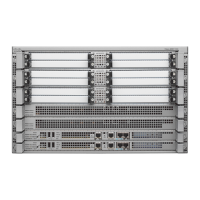What to Do Next
The following example of the show ppp multilink command shows the MLPPP type and the fragmentation
size:
Router#
show ppp multilink
Multilink1, bundle name is test2Bundle up for 00:00:13Bundle is Distributed0 lost fragments,
0 reordered, 0 unassigned0 discarded, 0 lost received, 206/255 load0x0 received sequence,
0x0 sent sequence Member links: 2 active, 0 inactive (max not set, min not set)Se4/2/0/1:0,
since 00:00:13, no frags rcvdSe4/2/0/2:0, since 00:00:10, no frags rcvdDistributed
fragmentation on. Fragment size 512. Multilink in Hardware.
.
Disabling Fragmentation on an MLPPP Bundle
By default, PPP multilink fragmentation is enabled. To disable fragmentation on a multilink bundle, use the
following commands:
SUMMARY STEPS
1.
Router# configure terminal
2.
Router(config)# interface multilink group-number
3.
Router(config-if)# ppp multilink fragment disable
DETAILED STEPS
PurposeCommand or Action
Enters global configuration mode.Router# configure terminal
Step 1
Specifies the multilink interface and enters multilink interface
mode, where:
Router(config)# interface multilink
group-number
Step 2
•
group-number—The group number for the multilink
bundle. Range 1-2147483647
Disables PPP multilink fragmentation.Router(config-if)# ppp multilink fragment
disable
Step 3
Configuring LFI
Link Fragmentation and Interleaving (LFI) is implemented on the QFP on the Cisco ASR 1000 Series
Aggregation Services Routers. QFP-based LFI supports LFI on a bundle with any number of links—from one
link, up to the maximum number supported by the router. When using LFI on MLPPP, the QFP load balances
the priority packets across all links in the bundle to minimize the latency on the priority interleaved traffic.
Cisco ASR 1000 Series Aggregation Services Routers SIP and SPA Software Configuration Guide, Cisco IOS
XE Everest 16.5
312 OL-14127-17
Configuring the 1-Port Channelized OC-3/STM-1 SPA and 1-Port Channelized OC-12/STM-4 SPA
Optional Configurations

